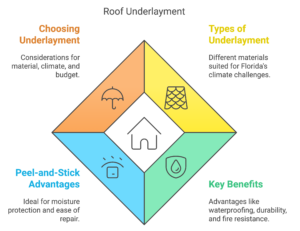Roof underlayment is an essential, though often overlooked, layer of protection for your home. In Florida’s unique climate—with intense sun, heavy rains, high humidity, and hurricane risks—choosing the right underlayment can mean the difference between a secure home and one vulnerable to weather-related issues. Let’s explore the role of underlayment, its benefits, and why it’s crucial for Florida homeowners.
1. What Is Roof Underlayment?
- Roof underlayment is a protective barrier installed between the roof deck and roofing materials (like shingles, tiles, or metal panels). Its main purpose is to add an extra layer of waterproofing and protection against leaks, wind, and moisture.
- In Florida, where high humidity and heavy rains are frequent, underlayment is especially important for preventing water intrusion and protecting your home’s structural integrity.
2. Types of Roof Underlayment for Florida Homes
- Asphalt-Saturated Felt: Traditionally used, asphalt-saturated felt is durable and cost-effective, but it may not withstand Florida’s harsh conditions as well as other options.
- Synthetic Underlayment: Lightweight, highly durable, and resistant to tearing, synthetic underlayment is ideal for Florida’s climate. It offers enhanced protection against water and UV exposure and holds up well in the face of high winds.
- Peel-and-Stick Underlayment: Designed for extreme moisture protection, peel-and-stick underlayment is waterproof, highly adhesive, and effective against Florida’s humid climate. It’s ideal for areas prone to heavy rains and wind, as it creates a watertight seal to prevent leaks.
3. Key Benefits of Roof Underlayment in Florida
- Added Waterproofing: Underlayment acts as an extra barrier, protecting your home from leaks. Florida’s intense rain and high humidity make this layer crucial for maintaining a dry and secure interior.
- Improved Durability: With the threat of hurricanes, high winds, and intense UV exposure, Florida roofs require materials that can withstand harsh conditions. Underlayment adds resilience to roofing systems, helping them last longer and remain effective.
- Enhanced Fire Resistance: Some types of underlayment offer additional fire resistance, which is beneficial for safety, especially in hot climates.
- Temperature Regulation: Certain underlayment materials can help moderate the home’s temperature by reflecting sunlight and insulating the roof, which is advantageous in hot, sunny regions.
4. Why Peel-and-Stick Underlayment Is Ideal for Florida’s Climate
- Peel-and-stick underlayment is highly recommended for Florida homes due to its strong adhesive qualities and watertight seal, which protect against rain and wind.
- It is designed to be UV-resistant and withstand prolonged exposure to the elements, making it durable during Florida’s hurricane season.
- Ease of Repair: Should damage occur, peel-and-stick underlayment is relatively easy to patch, providing ongoing protection without a complete overhaul.
5. How to Choose the Right Underlayment for Your Roof
- Consider the Roofing Material: Different underlayment materials may work better depending on your roof type (metal, tile, shingle, etc.).
- Evaluate Local Climate Conditions: In Florida, where storms, humidity, and sun exposure are extreme, high-quality synthetic or peel-and-stick options often outperform other choices.
- Factor in Maintenance and Budget: While high-quality underlayments may have a higher upfront cost, they can save you on maintenance and repairs in the long run.
Conclusion
Roof underlayment plays an essential role in protecting your home from Florida’s unpredictable climate. Choosing the right underlayment can help extend your roof’s lifespan, enhance energy efficiency, and prevent costly water damage. At Legion Roofing and Construction, we’re committed to ensuring your home is well-prepared for the elements. Contact us today for a FREE consultation, and let us help you select the perfect roofing and underlayment combination to secure your home in any weather.


